Abrupt Climate Warming is Associated with Effusive Volcanism
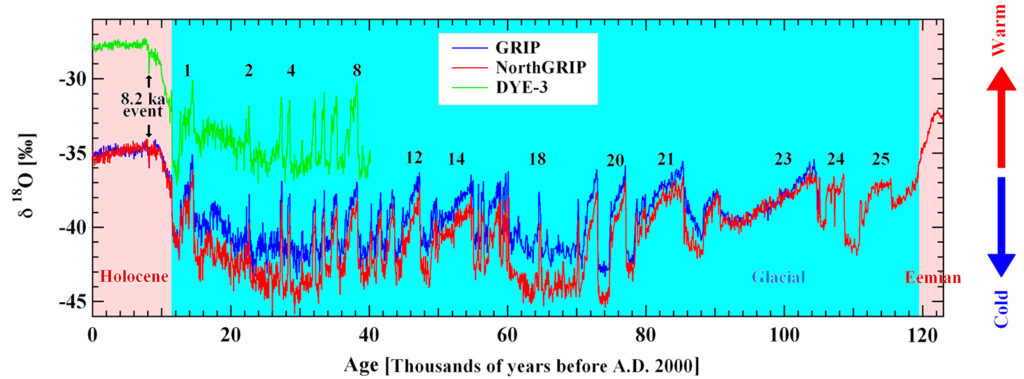
Twenty-five times in the last 120,000 years, according to the δ18O proxy for paleotemperatures in ice cores from Greenland (Dansgaard et al., 1993) (Stuiver, 2000), local temperatures rose 10 to 16oC in less than 40 years (Dansgaard et al., 1969) (Lang, 1999) (Severinghaus, 1999) (Landais, 2004) (Landais et al., 2005) (Huber et al., 2006) (Sánchez Goñi et al., 2008) and then returned to ice-age conditions more slowly, usually within centuries. These warmings might even have happened within years. For example, “the deuterium excess, a proxy of Greenland precipitation moisture source, switches mode within 1-3 years over these transitions” (Steffensen et al., 2008). These sudden warmings, known as Dansgaard-Oeschger events, occurred on average every 1470 years (Bond et al., 1999), but more at random than periodic intervals. Broecker and Denton (1989) argue that such “rapidity of glacial terminations” and “hemispheric synchronization” can only be explained by major reorganizations of the ocean-atmosphere system most likely triggered by sudden influxes of fresh water changing the North Atlantic thermohaline circulation (Boyle, 1987) and its effects on North Atlantic Deep Water formation (Sarnthein et al., 1994). Extensive literature over the past 25 years provides considerable detail from this perspective but fails to provide convincing evidence for how large volumes of fresh water from glacial melt can precede and therefore cause the warming. Since explosive volcanoes are well known to form stratospheric aerosols that cause cooling as explained on the page Volcanoes and Climate, most scientists have not considered clear evidence that effusive, basaltic volcanism might cause net warming and that the Dansgaard-Oeschger events might be driven by major basaltic, effusive volcanism well documented to have occurred under ice during some of these times.
The red bars in the figure on the left show the amount of volcanic sulfate measured in each layer between 9 and 16 Ka (thousand years before present) from the GISP2 borehole (Zielinski et al., 1996) (Data). Volcanic sulfate is total sulfate measured in each sample minus the generally small contributions from sea salt and continental dust based on associated concentrations of sodium and calcium (Mayewski et al., 1993 ) (Mayewski et al., 1997). The numbers in the blue circles show the number of contiguous layers containing volcanic sulfate (7 or more), a measure of how continuous the volcanism is. Each sampled layer in this section of the ice core represents an average of 3.2 years. The purple line is temperature based on δ18O data (White et al., 1997) (Data, Stacked). As snow accumulates, it forms firn, a layer of ice with interconnected air passages. The gases are not trapped within the ice until buried by 40 to 120 m of snow (Bender et al., 1997) (Severinghaus and Battle, 2006). Therefore the gas age is less than the layer age. The Meese/Sowers timescale relates depth in the GISP2 holes to layer age and to gas age (Meese and Sowers, 1994) (Data) Gas ages are typically 220 years younger from 0 to 10,000 years and 550 years younger around 15,000 years before present, reflecting the increasing rates of snow accumulation during warmer times. The δ18O proxy for temperature (purple line) is plotted as a function of gas age.
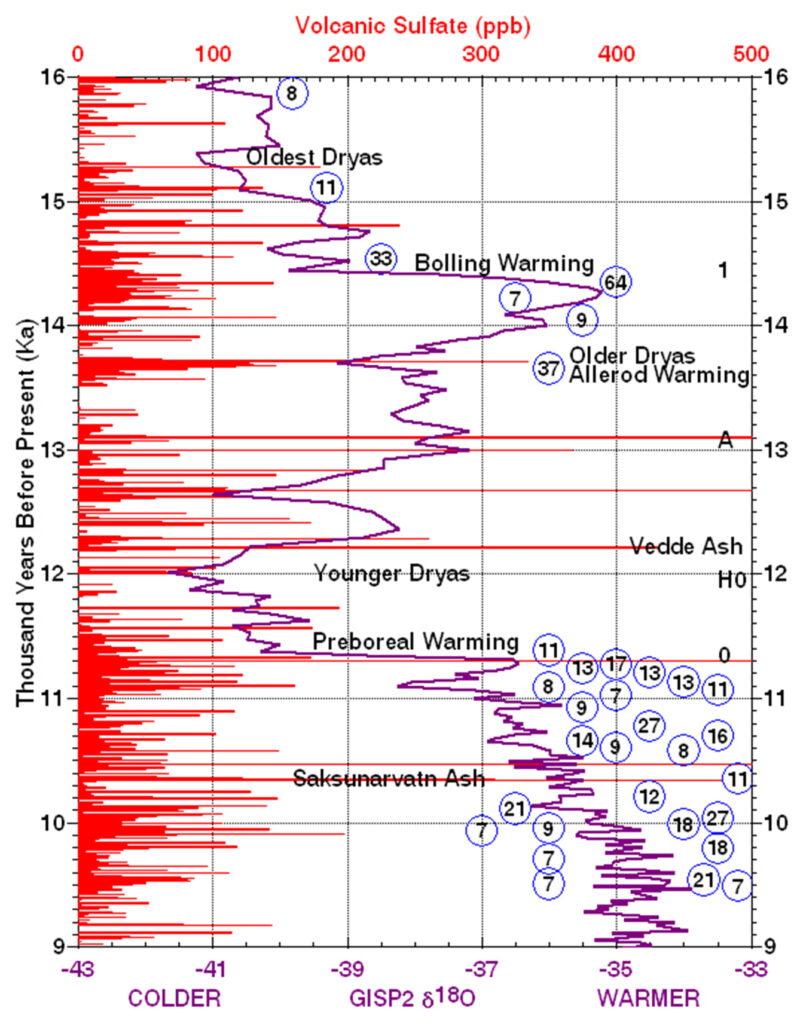
The largest sulfate anomaly of 801 ppb at 11.292 Ka followed by numerous contiguous layers of volcanic activity is contemporaneous with the rapid Preboreal warming. The Bølling warming begins with 33 contiguous layers (14.484 to 14.586 Ka =103 years) and then with 64 contiguous layers (14.235 to 14.457 Ka = 223 years). The Allerod warming coincides with 37 contiguous layers (13.577 to 13.732 Ka = 156 years) of volcanic sulfate. Single, even large, sulfate anomalies tend to be contemporaneous with cooling while sulfate in multiple contiguous layers tends to be contemporaneous with warming. Steffensen et al. (2008) document from detailed sampling of ice layers in Greenland that warming of as much as 10oC occurred within 3 years during the Bølling Warming and 60 years during the Preboreal Warming with corresponding increases in layer thickness of 40% due to increased precipitation.
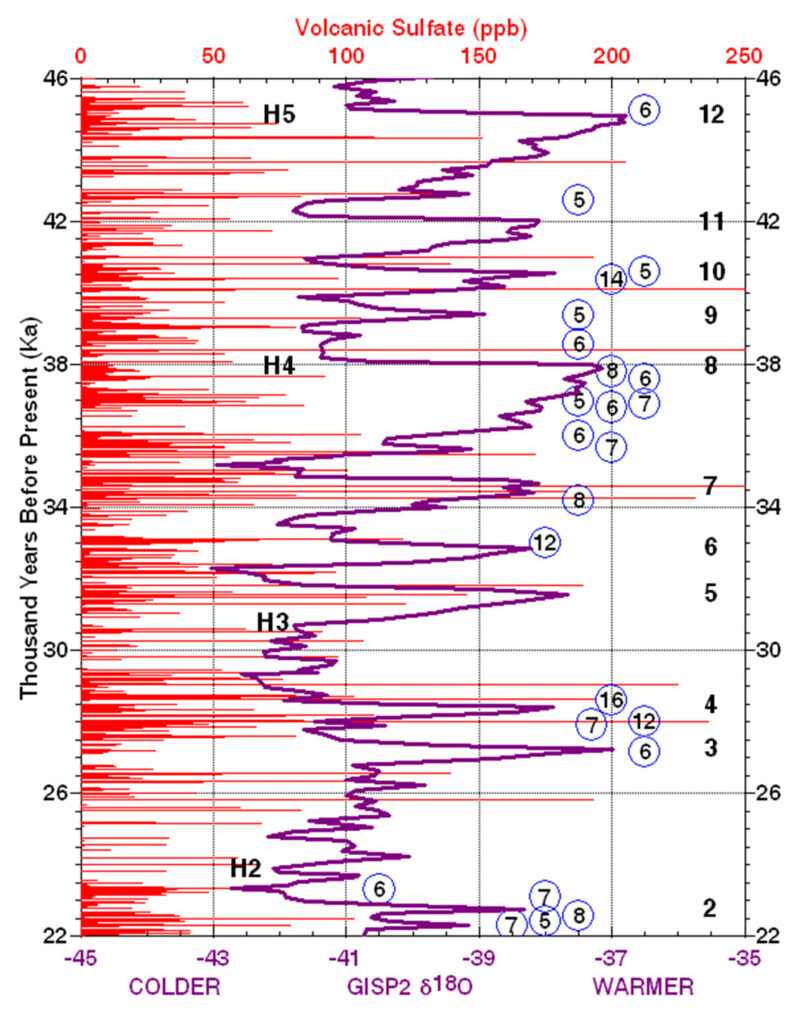
The red bars in the figure on the right show volcanic sulfate anomalies from 22 to 46 Ka from the GISP2 borehole (Zielinski et al., 1996). The numbers in the blue circles again show the number of contiguous layers containing volcanic sulfate (5 or more). Each sampled layer in this section of the ice core represents an average of 11 years. The purple line is temperature based on δ18O data based on gas age (White et al., 1997). Numbers 2 thru 12 are Dansgaard-Oeschger events (Ditlevsen et al., 2005). All warming phases except event 5 at 31.5 Ka are contemporaneous with volcanic sulfate in 5 or more contiguous layers. Event 5 is contemporaneous with much higher volcanic sulfate (795 ppb) than usual between 31.632 and 31.203 Ka (430 years), but not in more than 4 contiguous layers.
The association in time of volcanic sulfate and warming is particularly clear during the Bølling and Preboreal warmings with major decreases in sulfate during the colder periods: the Oldest Dryas, the Older Dryas, and the Younger Dryas. The ocean, whose surface covers 71% of the earth, provides the primary heat capacity in the climate system (Levitus et al., 2009). The heat capacity of the whole atmosphere is equal to the heat capacity of ~3.2 meters of the ocean, yet the average depth of the ocean is 3682 meters. Thus global warming requires warming the ocean. Equatorial Pacific sea surface temperatures during the last glacial maximum were approximately 3oC lower than today (Lea, 2000).
All major warming events in the past 46,000 years are contemporaneous with high rates of volcanism. Even short-term warming appears contemporaneous with increased volcanism when plotting the data on time scales sufficient to study individual layers. The data are most numerous and convincing since the last glacial maximum and decrease in number with age back to the lowest layers in the ice core (110.4 Ka). Generally when the amounts of volcanic sulfate increase rapidly for many years, global warming occurs. When this warming continues for decades to centuries, the ocean surface water is warmed. When the volcanism slows and stops, the deep thermal reservoir of the ocean cools Earth back into an ice age. When volcanism lasted a couple of thousand years during the pre-Boreal warming, the whole ocean was warmed out of the ice age.
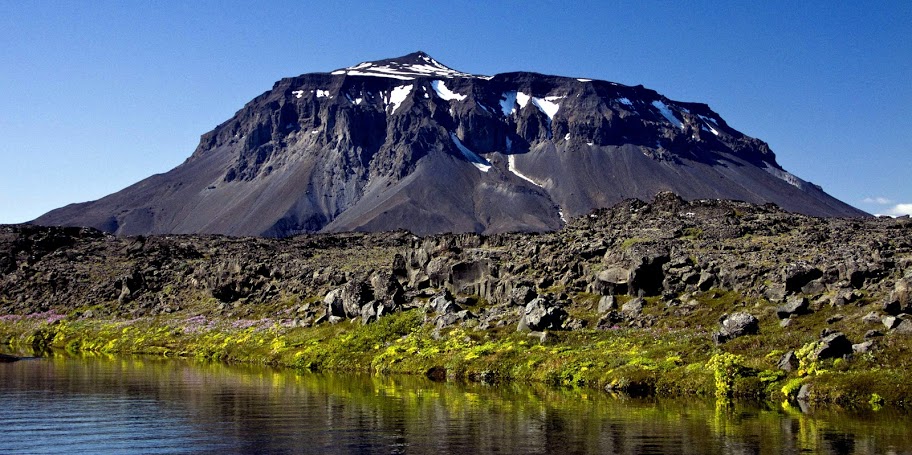
Basaltic volcanism under ice forms long, flat-topped, steep-sided table mountains or tuyas found throughout Iceland. “12 of the 13 dated table mountains experienced their final eruptive phase during the last glaciation” (Licciardi et al., 2007). Basalt typically spends years in small magma chambers on its way up through Earth’s oceanic crust, but most of the magma erupted between 13 and 9 Ka was particularly primitive basalts, pricrite, and olivine tholeite that rose more rapidly than usual, implying very high rates of flow (Gee et al., 1998) (Andrew and Gudmundsson, 2007). Melting of the 500 to 2000 meter thick ice-sheet (Einarsson and Douglas, 1994, page 265) might have increased magma production by decreasing the vertical loading on the top of the magma sources (Huybers and Langmuir, 2009). The relatively continuous high rate of most-likely basaltic volcanism from 11.7 to 9.8 Ka (2330 years), possibly assisted by increases in solar radiation due to Milanković cycles, was apparently sufficient to warm the ocean out of the last ice age (Ward, 2009, pdf).
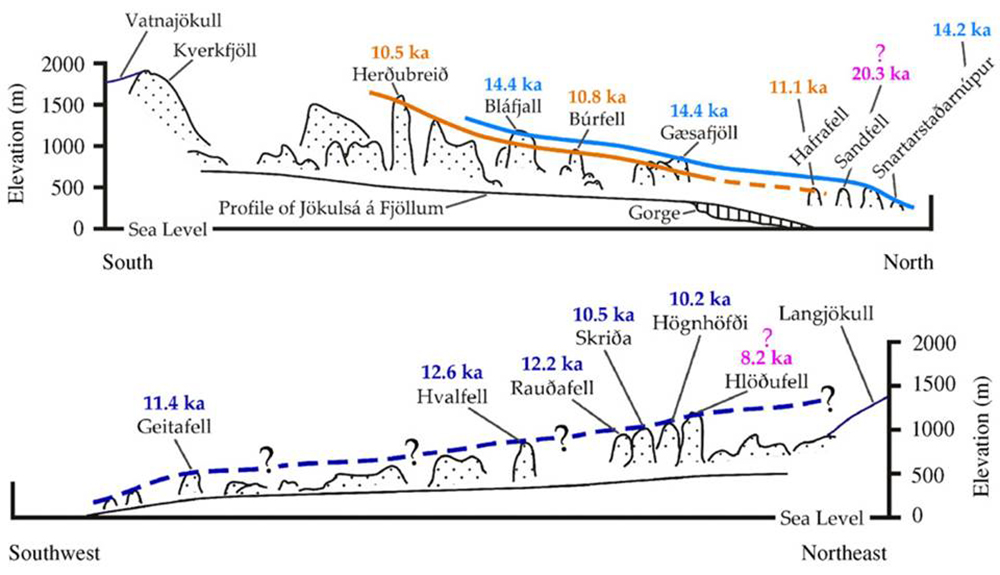
Volcanic sulfate deposits were similarly high during the other 13 Dansgaard-Oeschger sudden warmings between 46 and 11.6 Ka shown above (Rahmstorf, 2003) (Severinghaus, 1999). Approximately 11% of the surface area of Iceland is covered by the Móberg Formation, sub-glacial and intraglacial volcanic rocks and landforms generated during the Brunhes geomagnetic epoch to the end of the Pleistocene (780,000 to 10,000 Ka) (Einarsson and Douglas, 1994) (Jakobsson and Gudmundsson, 2008, pdf). There are numerous volcanic centers active at specific times throughout Iceland, but precisely dating the older systems has been difficult (Guillou and Van Vliet-Lano 2010).
A study spanning the last 12,000 years found that 47.5% of the tepha layers in Icelandic lakes were basaltic and 41% contained a basaltic component (Jagan, 2010). There are also some silicic volcanic systems in Iceland where magma may spend centuries in the crust and then erupt violently, causing net cooling. Silicic tephra are lighter in color, more easily recognized, and tend to dominate studies of tephra throughout Europe. Some well-known examples are the Saksunarvatn tephra around 10 Ka (Birks et al., 1996) and the Vedde ash around 11.98 Ka (Andrews et al., 2013). Unraveling the details of Icelandic volcanism and their relationship to warming and cooling over past centuries (Larsen, 2010), 300,000 years (Van Vliet-Lanoë et al., 2007) (Van Vliet-Lanoë et al., 2010), and 800,000 years (Barker et al., 2011) will take considerably more research.
Volcanism was also very active elsewhere during the end of the last ice age. Laacher See is a volcanic caldera lake in Rheinland-Palatinate, Germany, where a major eruption occurred around 12.9 Ka (Blockley et al., 2007). Volcanism was also high on the Kamchatka Peninsula in eastern Russia that would have been covered by ice during most of the Pleistocene (Ward, 2009, Table S1, pdf) (Excel version). The Kamchatka Penisula contains 160 volcanoes that are far more silicic than basaltic.
The human species, Homo sapiens, first appeared around 200,000 years ago. Up until 10,000 years ago, modern humans lived primarily under ice-age conditions and survived at least 34 abrupt warmings occurring within years to a decade but lasting for many generations. Human migrations out of Africa most likely occurred during these warmings as proposed by the Sahara pump theory, and those living in polar regions as the climate cooled again either found ways to adapt, migrated back to the tropics, or died. During warm periods, man had time to do more than just survive. For example, a gigantic eruption of the Phlegraean Fields in Italy at 39.28 Ka was followed by Heinrich event H4 (38 Ka) (Hemming, 2004), Dansgaard-Oeschger event 8 (38.35 Ka) (Ditlevsen et al., 2005), a warm period lasting nearly 2000 years, the Middle to Upper Paleolithic cultural transition and the replacement of Neanderthal populations by anatomically modern humans.
Understanding the nature and precise ages of abrupt climate change should help resolve the very active debate (for example Maher et al., 2011) over the influence of climate on humanity. The basic reality of life is that all living things spend every moment of life adapting to their physical and social climates.
Volcanism, especially basaltic, effusive volcanism, provides a direct explanation for observed abrupt climate change. It also explains the source of large amounts of fresh water in the North Atlantic. Subglacial eruptions in Iceland melt ice, forming large sub-glacial lakes that suddenly release in outburst floods or jökulhlaups (Geirsdottir et al., 2000) (Maizels, 1991). Once volcanism initiates global warming, major lakes form around the base of continental ice sheets, ultimately draining catastrophically into oceans. Examples include Lake Agassiz, Lake Missoula, Lake Bonneville, Lake Ojibway, West Siberian Lake, and the English Channel (Gupta et al., 2007).